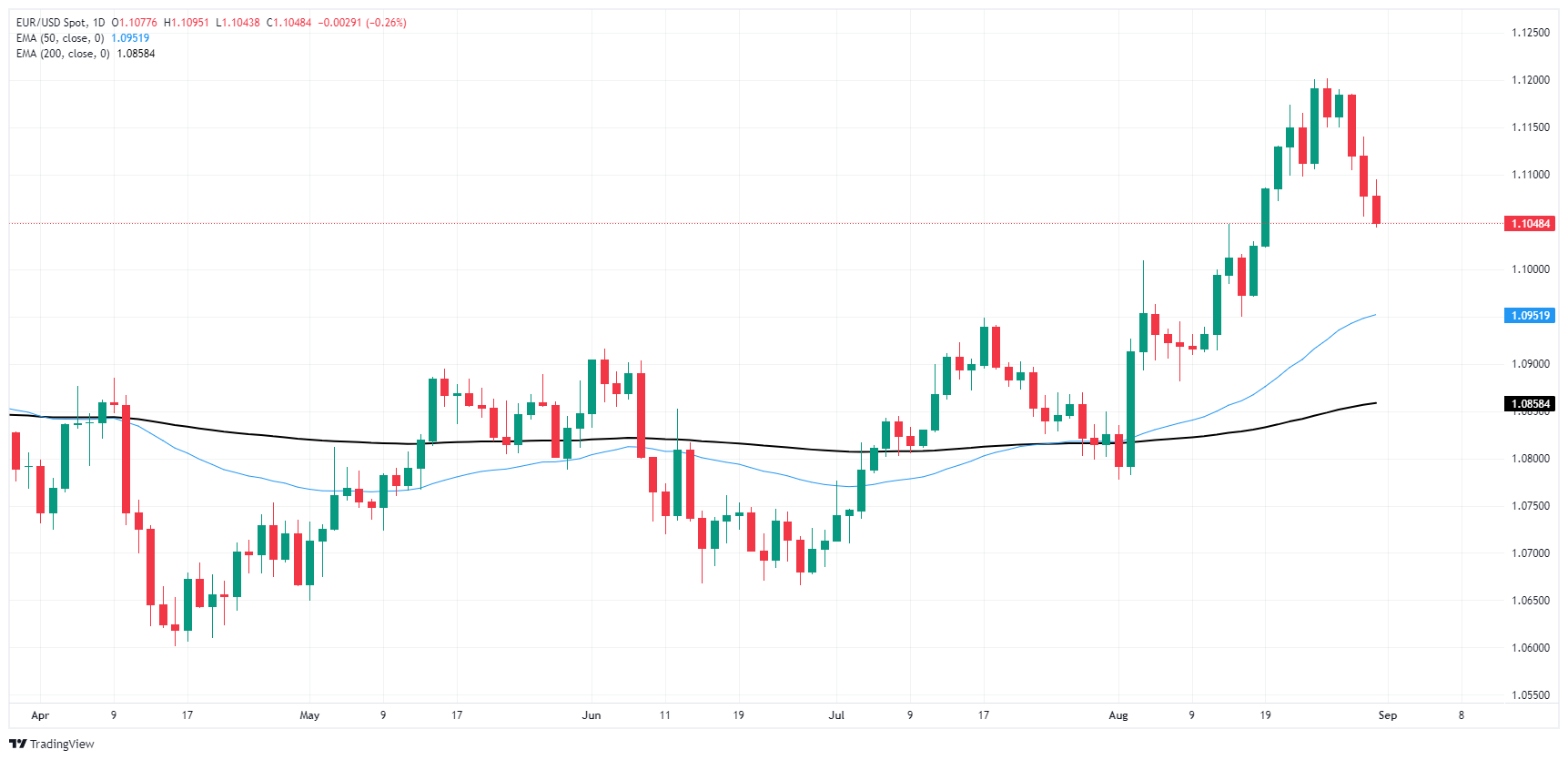- EUR/USD trimmed to the downside on Friday, extending into a three day down streak.
- EU inflation brought no surprises, US PCE inflation kept rate bets on balance.
- Coming up next week: Last US NFP jobs data print before next Fed rate call.
EUR/USD tilted further into the red on Friday, extending a downside move into a third straight day and dragging Fiber down to 1.1050 to round out the trading week. EU inflation figures released early Friday failed to impress anybody in particular, and US Personal Consumption Expenditure Price Index (PCE) didn’t stray far from forecasts, keeping broad-market bets on rate cuts aimed squarely at the Federal Reserve’s (Fed) next rate call on September 18.
US PCE figures for July didn’t deliver any notable surprises to round out the trading week. MoM US core PCE inflation held steady at 0.2%, as expected, but the YoY core PCE inflation figure held steady at 2.5% versus the anticipated move up to 2.6%.
Rate markets are holding firmly to 30% odds of an initial double cut for 50 bps from the Federal Reserve (Fed) on September 18, with the remaining 70% leaning into a single quarter-point cut. Overall, rate traders are pricing in 100 bps in total cuts in 2024, according to CME’s FedWatch Tool.
With PCE inflation data out of the way and not giving any warning signs, the way is paved to next week’s Nonfarm Payrolls (NFP) print, one of the last key pieces of economic data standing in the way of the Fed and rate-cut-hungry markets. Next week will also open on a quiet note, with US exchanges slated to remain shuttered for the Labor Day holiday. Some Purchasing Managers Index (PMI) releases are also scattered throughout the trading week.
EUR/USD price forecast
A third downside has tilted Fiber firmly into a bearish pullback, and EUR/USD price action is already halfway to the nearest technical level at the 50-day Exponential Moving Average (EMA) rising through 1.0950.
While EUR/USD is still trading firmly in bull country north of the 200-day EMA at 1.0855, bids have dropped the Fiber precipitously from yearly peaks reached earlier this week, and bearish momentum could develop some heat.
EUR/USD daily chart
Euro FAQs
The Euro is the currency for the 20 European Union countries that belong to the Eurozone. It is the second most heavily traded currency in the world behind the US Dollar. In 2022, it accounted for 31% of all foreign exchange transactions, with an average daily turnover of over $2.2 trillion a day. EUR/USD is the most heavily traded currency pair in the world, accounting for an estimated 30% off all transactions, followed by EUR/JPY (4%), EUR/GBP (3%) and EUR/AUD (2%).
The European Central Bank (ECB) in Frankfurt, Germany, is the reserve bank for the Eurozone. The ECB sets interest rates and manages monetary policy. The ECB’s primary mandate is to maintain price stability, which means either controlling inflation or stimulating growth. Its primary tool is the raising or lowering of interest rates. Relatively high interest rates – or the expectation of higher rates – will usually benefit the Euro and vice versa. The ECB Governing Council makes monetary policy decisions at meetings held eight times a year. Decisions are made by heads of the Eurozone national banks and six permanent members, including the President of the ECB, Christine Lagarde.
Eurozone inflation data, measured by the Harmonized Index of Consumer Prices (HICP), is an important econometric for the Euro. If inflation rises more than expected, especially if above the ECB’s 2% target, it obliges the ECB to raise interest rates to bring it back under control. Relatively high interest rates compared to its counterparts will usually benefit the Euro, as it makes the region more attractive as a place for global investors to park their money.
Data releases gauge the health of the economy and can impact on the Euro. Indicators such as GDP, Manufacturing and Services PMIs, employment, and consumer sentiment surveys can all influence the direction of the single currency. A strong economy is good for the Euro. Not only does it attract more foreign investment but it may encourage the ECB to put up interest rates, which will directly strengthen the Euro. Otherwise, if economic data is weak, the Euro is likely to fall. Economic data for the four largest economies in the euro area (Germany, France, Italy and Spain) are especially significant, as they account for 75% of the Eurozone’s economy.
Another significant data release for the Euro is the Trade Balance. This indicator measures the difference between what a country earns from its exports and what it spends on imports over a given period. If a country produces highly sought after exports then its currency will gain in value purely from the extra demand created from foreign buyers seeking to purchase these goods. Therefore, a positive net Trade Balance strengthens a currency and vice versa for a negative balance.
Information on these pages contains forward-looking statements that involve risks and uncertainties. Markets and instruments profiled on this page are for informational purposes only and should not in any way come across as a recommendation to buy or sell in these assets. You should do your own thorough research before making any investment decisions. FXStreet does not in any way guarantee that this information is free from mistakes, errors, or material misstatements. It also does not guarantee that this information is of a timely nature. Investing in Open Markets involves a great deal of risk, including the loss of all or a portion of your investment, as well as emotional distress. All risks, losses and costs associated with investing, including total loss of principal, are your responsibility. The views and opinions expressed in this article are those of the authors and do not necessarily reflect the official policy or position of FXStreet nor its advertisers. The author will not be held responsible for information that is found at the end of links posted on this page.
If not otherwise explicitly mentioned in the body of the article, at the time of writing, the author has no position in any stock mentioned in this article and no business relationship with any company mentioned. The author has not received compensation for writing this article, other than from FXStreet.
FXStreet and the author do not provide personalized recommendations. The author makes no representations as to the accuracy, completeness, or suitability of this information. FXStreet and the author will not be liable for any errors, omissions or any losses, injuries or damages arising from this information and its display or use. Errors and omissions excepted.
The author and FXStreet are not registered investment advisors and nothing in this article is intended to be investment advice.
Recommended content
Editors’ Picks

EUR/USD holds losses below 1.0500 on Trump’s tariff uncertainty
EUR/USD keeps losses below 1.0500 in the European trading hours on Thursday. The pair suffers from a sustained US Dollar recovvery-led by US President Trump's conflicting messages on tariffs. Traders now look to the ECB Minutes, US GDP revision and Trump-speak for impetus.

GBP/USD remains depressed below 1.2700 amid US Dollar strength
GBP/USD remains depressed below 1.2700 in European trading on Thursday. Broad US Dollar strength and cautious mood, amid US President Trump's tariff uncertainty, weigh down on the pair ahead of key US macro releases and more Trump talks.

Gold falls on Trump creating more confusion about tariffs
Gold’s price faces strong selling pressure and extends this week’s correction to hit a ten-day low near $2,880 on Thursday. The leg lower comes after US President Donald Trump cast doubts and confusion during a cabinet meeting on Wednesday about what levies will be applied, when, and to which countries.

Solana Price Forecast: DTCC lists first SOL futures ETF, will it avert $130 breakdown?
Solana price tumbled from $172 to $134 this week as FTX estate’s impending token unlock looms ahead despite early gains from a new SOL ETF listing.

February inflation: Sharp drop expected in France, stability in the rest of the Eurozone
Inflation has probably eased in February, particularly in France due to the marked cut in the regulated electricity price. However, this overall movement masks divergent trends. Although disinflation is becoming more widespread, prices continue to rise rapidly in services, in France as well as elsewhere in the Eurozone.

The Best brokers to trade EUR/USD
SPONSORED Discover the top brokers for trading EUR/USD in 2025. Our list features brokers with competitive spreads, fast execution, and powerful platforms. Whether you're a beginner or an expert, find the right partner to navigate the dynamic Forex market.